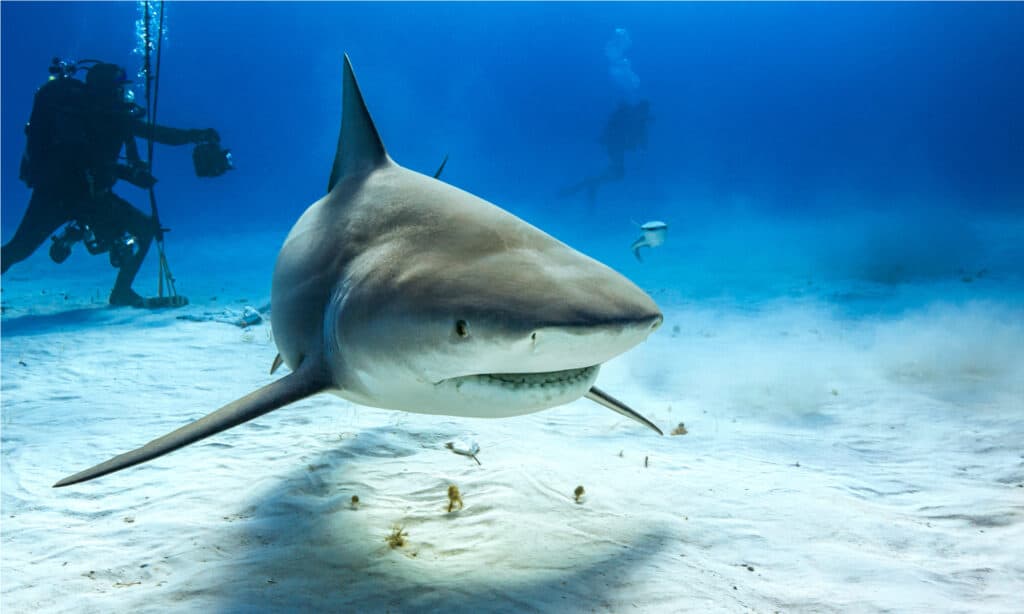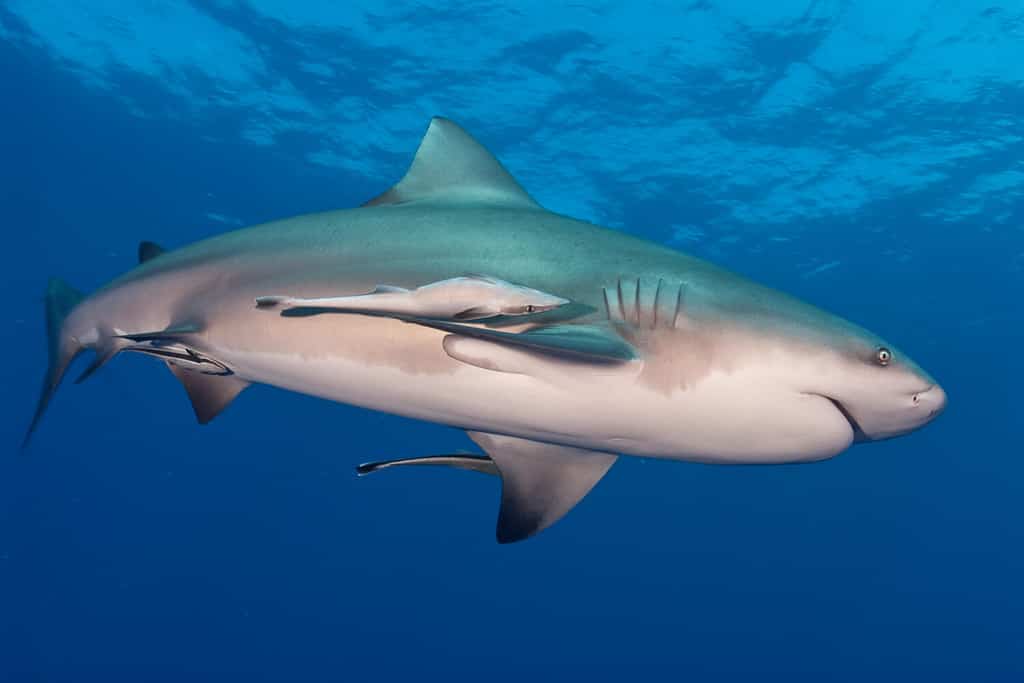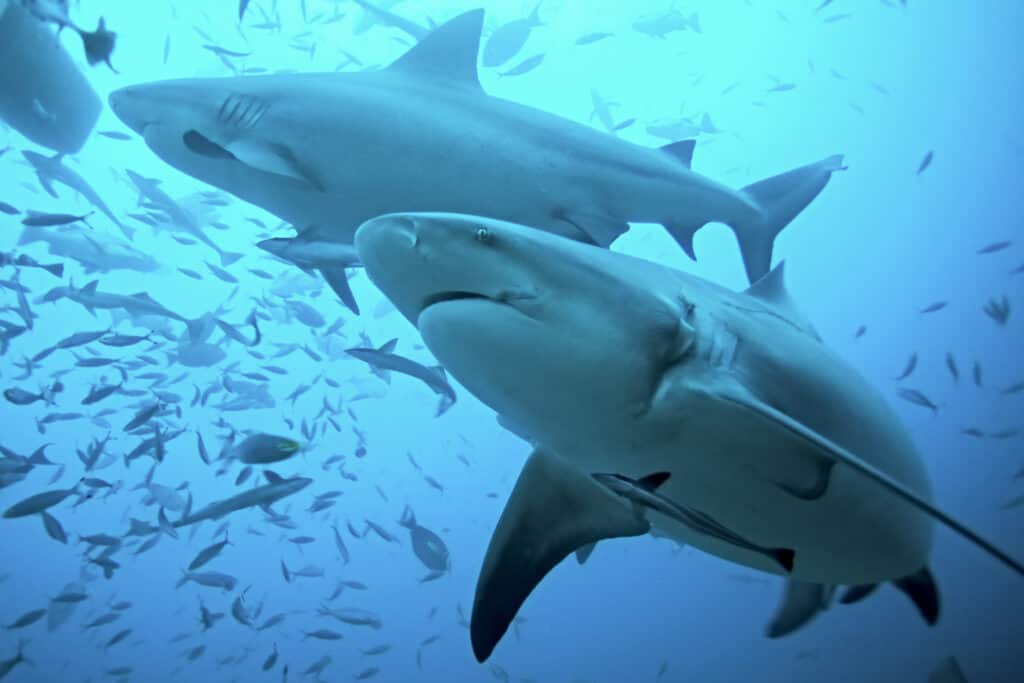You’ve likely seen those ominous shark fin photos and videos, gliding through the water like a submarine. And if it’s a bull shark, it could be a big one!
Bull sharks don’t mess around when it comes to size. They are one of the larger shark species and definitely one of the most aggressive.
Some key points on bull shark sizes:
- Bull sharks average 6 feet long but can reach up to 11-12
- They can weigh over 507 pounds at full size
- Females are larger than males on average
- While both bull sharks and great white sharks can grow to significant sizes, great white sharks are generally larger on average compared to bull sharks
Let’s dive into how truly massive bull sharks can grow.
Bull sharks have a notorious reputation for being aggressive, territorial predators. Their stout bodies and blunt rounded snouts are unmistakable.
Great whites usually come to mind when you picture sharks that can reach mammoth proportions. However, bull sharks also grow to immense sizes comparable to white sharks.
Seeing an 8-10 foot bull shark in person can be intimidating. Anything over 10 feet classified as a monster bull shark becomes more enormous.
What are the largest bull shark sizes documented? How big do bull sharks get compared to other shark species and large animals? Let’s find out!

Bull sharks can reach up to 13 feet!
©Carlos Grillo/Shutterstock.com
Bull Shark Size Compared to Other Shark Species
Bull sharks belong to the Carcharhinidae family along with other requiem sharks like tiger sharks, lemon sharks, and more. Here’s how they stack up in size:
Great White Sharks – The largest great white ever recorded was over 20 feet long. Though they average 10-15 feet.
Tiger Sharks – Tiger sharks rival bull sharks in size, reaching over 18 feet long in rare cases. Their average is 10-14 feet.
Bull Sharks – The biggest bull sharks can reach 13 feet long and weigh over 500 pounds. But 8-11 feet is more common.
Mako Sharks – Shortfin mako sharks are smaller but still large at 8-13 feet on average.
So while great white and tiger sharks take the cake for maximum size, bull sharks are right up there, reaching similar lengths. 13 feet is the upper limit for bull sharks, though larger undocumented ones could exist.

A bull shark can overpower a person if they were side by side!
©Fiona Ayerst/Shutterstock.com
Bull Shark Size Compared to Humans
Standing next to even a juvenile 6-7 foot bull shark puts their size into perspective. A shark that size can easily dwarf an average size human.
To imagine how enormous a full-grown 10+ foot bull shark is, picture three adult humans lying head to toe. That’s the approximate length of some massive mature bull sharks.
They can weigh over 500 pounds, comparable to a full-grown polar bear. The sheer mass and girth of these sharks are impressive and intimidating.
Seeing footage of divers next to giant bull sharks emphasizes how big they are compared to humans. We look tiny in comparison!

A bull shark is bigger than a Toyota Corolla’s length.
©Martin Prochazkacz/Shutterstock.com
Bull Shark Size Compared to Cars
Another way to visualize how massive monster bull sharks can be is to picture them next to a car.
A 12-13 foot shark would take up nearly the entire length of a compact sedan like a Honda Civic or Toyota Corolla.
An SUV like a Jeep Cherokee or Toyota RAV4 is under 15 feet long, so that a huge bull shark would be nearly the same length.
Even a pickup truck bed on models like the Ford F-150 is only 5-6 feet – the length of a juvenile bull shark. A full grown bull shark would hang well off the back!
So your average bull shark is about the size of a small to mid-sized car or truck. The giants are as long as an entire large vehicle, an intimidating thought to ponder.
Where You Can Find Bull Sharks
Now that you know how massive bull sharks can grow, where can you see them in person?
Bull sharks have an expansive habitat across subtropical and tropical oceans globally. Here are some top places to potentially spot bull sharks:
Florida – Multiple spots off the Florida coast are famous bull shark habitats, like Jupiter Inlet and the Indian River Lagoon.
Australia – Bull shark populations thrive along the eastern and northern Australian coastlines.
Fiji – Pacific island groups like Fiji offer clear water diving with bull sharks.
Bahamas – Nassau and other areas in the Bahamas host bull shark populations that draw tourism.
South Africa – Bull sharks congregate off the coast of South Africa, especially around Durban.
Sri Lanka – The warm Sri Lankan waters near Colombo bring in many bull sharks.
There are plenty more shark hotspots worldwide, but these destinations consistently offer prime bull shark sightings. The next time you’re snorkeling or diving in these places, keep an eye out beneath you!
Conclusion
To summarize, bull sharks rival great whites and tigers as some of the largest shark species. They can unquestionably reach gargantuan sizes, over 12 feet long and 500 pounds.
Their stout build and aggression mean adult bull sharks demand respect in the water. Understanding how enormous bull sharks grow compared to people and vehicles puts their impressive dimensions into perspective.
So if you see a massive shadowy form gliding through shallow coastal waters, there’s a good chance it’s a bull shark! Always admire these apex predators from a safe distance as they command their domain.
The photo featured at the top of this post is © Fiona Ayerst/Shutterstock.com
Thank you for reading! Have some feedback for us? Contact the AZ Animals editorial team.







